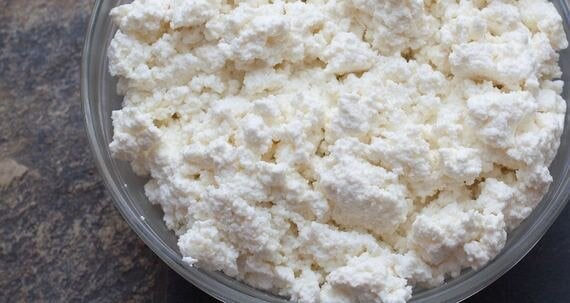
Besides the delicious taste and creamy texture of fresh ricotta cheese, it's versatile and super-healthy-high in protein and calcium, yet low in sodium and fat. Plus it's easy to make-it requires only milk and an acid like vinegar. The milk is heated with the acid, which causes the curds and whey to separate. Once separated, the curds are drained and it's ready to eat.
Commercially prepared ricotta cheese is available as whole milk, part-skim and fat-free. Unfortunately, most store-bought brands are laden with gums and stabilizers like carrageenan, which affect the fresh taste and naturally creamy texture. Many of the organic brands have also added carrageenan.
Carrageenan is one of the most controversial additives in the natural food industry. It's made from seaweed and used as a thickener and stabilizer in dairy products like cottage cheese, yogurt, ricotta cheese and ice cream. It keeps the water from separating out of the dairy. Consumers believe that a product is bad when they buy a container of fresh cheese and it's watery. Really, all you have to do is stir the contents and the taste and texture will be much better than those with added gums.
Research linking consumption of carrageenan to intestinal inflammation is causing the organic industry to take a closer look into whether or not it should be allowed in organic foods. USDA (United States Department of Agriculture) certified-organic foods must have 95 percent of its ingredients organic, which means that five percent of the ingredients may not be organic. According to USDA, carrageenan can only be added to certified-organic food when it is deemed "essential" to the manufacturing of the product. With respect to fresh cheese production, carrageenan cuts the draining time and keeps the excess moisture from leaking out.
The question remains-is carrageenan essential? The answer is no! There are old-fashioned brands and artisanal producers that don't use it all. And when I was growing up, it was never found in yogurt or ricotta cheese. Many of the trusted brands recently started adding carrageenan.
For example, in the U.S. I could only find one brand made with fat free milk that did not contain a stabilizer. The ingredients are skim milk, starter and salt. One-quarter cup is 30 calories, 25 milligrams sodium, 6 grams protein and delivers 12 percent of the daily value for calcium. It's made in Connecticut so it has limited distribution. If only it was made with organic 100 percent grass-fed milk! I guess you can't have everything unless you make it at home!
Easy Ricotta Cheese Recipe
Ingredients (choose organic and 100 percent grass fed milk when available):
- 2 cups low fat milk, (do not use shelf stable UHT or ultra-pasteurized milk)
- 1/4-teaspoon sea salt (optional)
- 2 tablespoons white vinegar
Line a colander with two layers of unbleached paper towels or unbleached coffee filters. Then place the colander over a large bowl to catch the liquids and set aside.
In a large saucepan combine milk and salt and bring to a simmer, which means below the boiling point - do not boil! Bubbles should barely break the surface of the milk.
Remove from heat and add vinegar, gently stir for about five seconds - but do not over mix. Then let stand for five minutes. Milk should separate into solid white curds and liquid whey.
Using a slotted spoon, transfer the curds to the colander and cover the top with plastic wrap. Place in refrigerator and allow the curds to drain until desired consistency. If you like a firm, dry consistency then drain overnight. For a moist, creamy texture then drain for five minutes.
Makes about 1/2 cup fresh ricotta.
Notes:
- Ricotta can be stored in the fridge for up to five days.
- You can save the liquid whey and add it to a smoothie.
- Using low fat milk results in a better product compared to using fat free milk. The higher the fat content, the better the yield.
- Don't use ultra-pasteurized milk because the protein structure is changed and the milk won't separate.
For more healthy recipes and a diet geared towards optimal health without deprivation, pick up a copy of Layne's book: Beyond The Mediterranean Diet: European Secrets Of The Super-Healthy.
Bon Appétit!